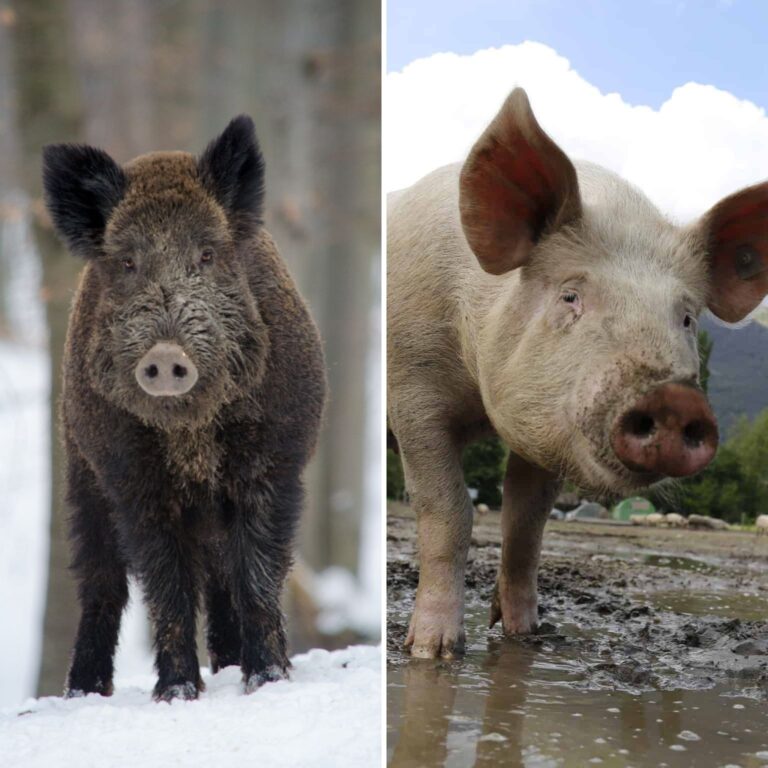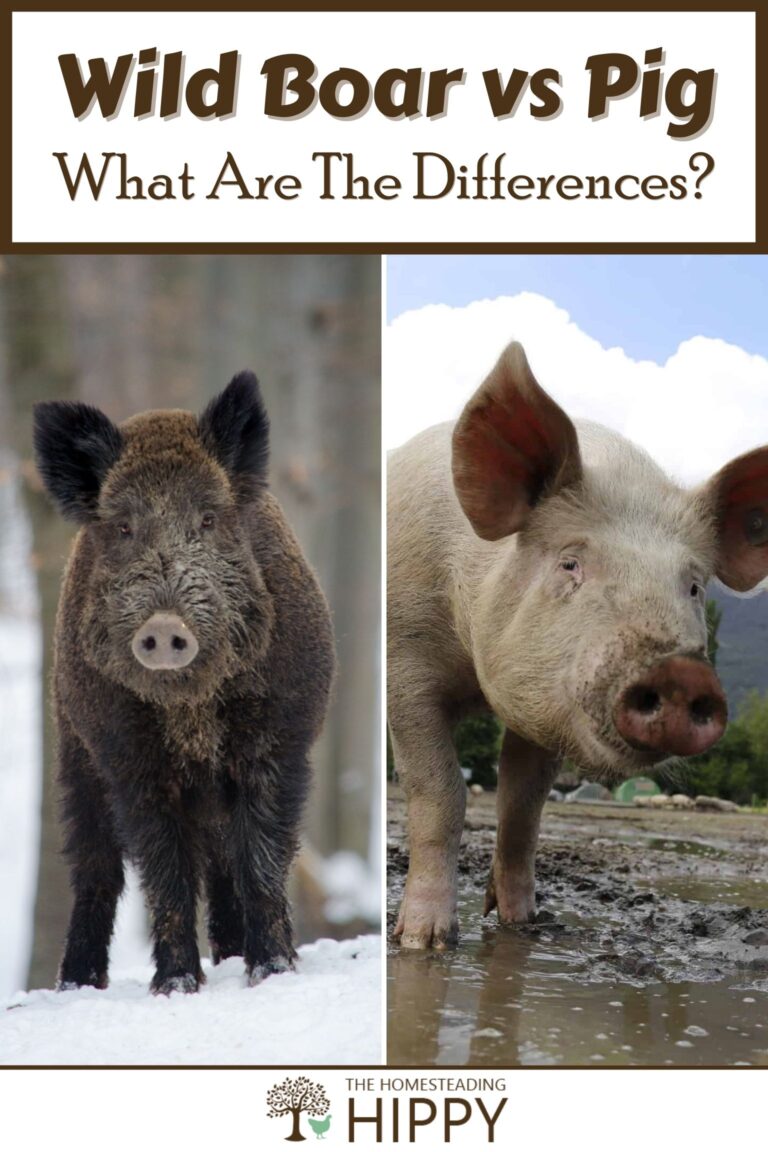If you’ve ever found yourself wondering what the differences are between wild boars and domestic pigs, you aren’t alone. Pigs, hogs, wild hogs, feral pigs: there are enough terms being tossed around to fill half a dictionary at least.

But in any case, pigs are both big business and big trouble: seems we constantly hear about the market factors of pork and in the next breath dire warnings about wild ones tearing up the environment and terrorizing people.
We already know the differences between hogs and pigs, but how about boars? What are the differences between wild boars and pigs?
Wild boars are wild, indigenous or invasive swine species while pigs usually refer to domesticated pigs, whether or not they have escaped and gone feral. The terms are often used interchangeably, adding to the confusion.
One big problem that defies easy comparison is the fact that domestic pigs often escape, go feral, and comingle.
They then breed explosively to produce subsequent generations and huge populations of “wild” pigs that become indigenous to areas where they were not originally present.
At any rate, if you want to know more about wild boars and pigs, keep on reading.
| Feature | Wild boars | Domesticated pigs |
|---|---|---|
| Adult male weight | 130 to 250 pounds (58 to 113 kgs) | 200 to 1000 pounds |
| Adult female weight | 110 to 200 pounds | 450 to 700 pounds |
| Male length | 59 to 78 inches | 36 to 80+ inches |
| Female length | 55 to 70 inches | 33 to 78+ inches |
| Male height, to shoulder | 28 to 35 inches | 20 to 40+ inches |
| Male height, to shoulder | 27 to 34 inches | 18 to 37+ inches |
| Appearance | More athletic and muscular | Chubbier, “softer” |
| Tusks | Longer | Shorter |
| Snout | Elongated | Shorter |
Size and Weight
Wild boars and domestic pigs are very similar, but have evolved differently due to selective breeding in the case of the domestic pig, and the environments they inhabit in the case of wild hogs.
But there are several notable physical differences between the two, with variations in both males and females…
Male wild boars, known as just “boars,” are generally larger and heavier than female wild boars, known as sows.
Adult male wild boars typically weigh between 130 to 250 pounds (58 to 113 kgs) depending on subspecies, while some large individuals to 330 pounds (150 kilos).
Exceptionally huge specimens found in Northern Asia might tip the scales at more than 700 pounds! Most wild boar males measure around 59 to 78 inches in length, with a shoulder height averaging 35 inches.
Female wild boars are significantly smaller as expected, with an average weight ranging from 110 to 200 pounds, though the ladies of some subspecies are quite a bit larger than that.
They measure approximately 55 to 70 inches in length on average, with a shoulder height of around 31 inches.
But on the other hand, and contrary to popular belief, domestic pigs tend to be much, much larger than most wild hogs.
This is because they have been selectively bred for meat production, which has resulted in larger and heavier animals that pack on weight very quickly compared to their truly wild kin.
Even so, the size and weight of domestic pigs vary greatly depending on the breed and purpose.
Male domestic pigs, also known as boars, can weigh anywhere from 200 to 1000 pounds or even more. Some of the large breeds like the Duroc and Yorkshire can easily reach up to 800 pounds on average.
Female domestic pigs, also known as sows like their wild cousins, are also considerably larger than their wild counterparts, typically.
They generally weigh between 450 to 700 pounds, with some breeds like the Landrace and Large White reaching up to 600 pounds.
Appearance
Wild boars and domestic pigs exhibit considerable differences in their physical appearance, despite being the same species.
Wild boars typically have a more athletic and muscular physique, overall, compared to domestic pigs. Their bodies are compact and barrel-shaped, with a thick neck and strong shoulders.
They have relatively long, straight legs that provide them with agility and speed when navigating through dense forests and rugged terrain.
The fur of wild boars is also coarse and dense, far more so than the typical domestic pig, and this provides protection against harsh weather conditions and a degree of protection against predators.
Their coloration varies from dark brown to black, sometimes with lighter shades on the underside.
Wild boars also possess a distinct mane that runs along their spine, which can be raised when they feel threatened, much like the hair of a cat!
This is what has led to the common North American nickname of such hogs: razorbacks!
Another prominent feature of wild boars is their elongated snout, which ends in a flat, round disc at the nostrils. This adaptation allows them to more easily root for food in the soil.
Their tusks, which are enlarged canine teeth, are another iconic characteristic. Males have larger, usually curved tusks that can grow up to 10 inches in length depending on the subspecies, while females have smaller, straighter tusks. In all cases, these tusks are ferocious weapons!
In contrast, domestic pigs have a more rounded, “softer” and heavyset body, with shorter legs relative to their size.
Their physique is less impressive but can still be quite muscular, though more fatty as a rule – again the result of selective breeding for meat production. They also have a less prominent neck and shoulders compared to wild boars.
Domestic pigs have a softer, finer coat, which can vary in color and pattern depending on the breed.
Some breeds, like the Large Black and Tamworth, tend to have a solid color, while others, like the Gloucestershire Old Spot, display distinctive spots or patches.
With pale colors and sparse, thinner hair, some domestic pigs can look entirely bald from even a short distance.
And coming back around to the nose, the snout of domestic pigs is typically shorter and more upturned than that of wild boars, making them somewhat less adapted for rooting, though they still do plenty of it when given opportunity.
While some domestic pigs still have tusks, they are generally smaller and less pronounced than those of wild boars, and often snipped or filed down by keepers as a rule to prevent unnecessary injury of people and other pigs.
Behavior and Diet
One area where pigs and wild hogs are quite comparable is in regards to their nominal diet, but their behavior and attitudes tend to vary markedly.
Wild boars are highly adaptable and can thrive on a wide variety of plants, roots, fruits, insects, and small animals. Wild boars use their strong snouts to dig and root for food in the ground.
Socially, wild boars form groups called sounders, which typically consist of females and their offspring. Males are usually solitary, only joining sounders during the breeding season.
Wild boars are known for their aggressive behavior, especially when they are surprised, feel threatened, or are cornered. They will use their tusks on the charge to defend themselves and their young ferociously.
But domestic pigs have been raised by humans for thousands of years and are accustomed to living in controlled environments, such as farms and pens.
Their behavior has thus been shaped by both selective breeding and human interaction, making them more docile and sociable compared to their wild counterparts, though neglected or feral pigs are still capable of shocking aggression.
Domestic pigs are as omnivorous as their wild kin, but their diet is primarily determined by their caretakers, often consisting of grains, vegetables, and other food scraps, though some pigs will be allowed to root and forage.
If given the opportunity, this behavior is typically less pronounced than in wild boars.
In terms of social behavior, domestic pigs are generally more gregarious and less aggressive than wild boars. They can form strong bonds with other pigs and even with humans.
Domestic pigs are also known for their intelligence and curiosity, which has led to their use in various research studies and even significant popularity as pets in some cases.
Genuine Wild Boar? Or Feral Domestic Pig?
The distinctions between wild boars and domestic pigs can become further blurred due to the presence of escaped domestic pigs that “return to nature” (return to hog?) and turn feral.
This phenomenon has led to the emergence of hybrid populations, which can exhibit a mix of physical traits from both wild boars and domestic pigs.
Moreover, these feral domestic pigs can grow to monstrous sizes according to their breeding and might be mistaken for genuine wild hogs.
When domestic pigs escape from farms or are intentionally released into the wild, over time they adapt to their new environment, developing characteristics more suited to wilderness survival.
They often interbreed with wild boars, resulting in hybrid offspring that possess a combination of traits from both parent species.
This creates a diverse population with varying appearances (though mostly uniform behaviors), making it difficult to distinguish between true wild boars and feral pigs in many regions.
One serious concern arising from the presence of feral pigs is their potential to grow to truly enormous sizes with more regularity compared to most wild boars.
With access to abundant food sources and the influence of domestic pig genetics, some feral pigs pose a huge threat to native ecosystems, agriculture, and even human safety.
Feral pigs exhibit aggressive behavior similar to wild boars, especially when defending their territory or young.
The increasing prevalence of feral pigs in some regions, including urban areas, has raised growing concerns about the impact on native flora and fauna, as these feral populations have few predators and far too few of the ones that do exist.

Tom has built and remodeled homes, generated his own electricity, grown his own food and more, all in quest of remaining as independent of society as possible. Now he shares his experiences and hard-earned lessons with readers around the country.
Find out more about the team here.
